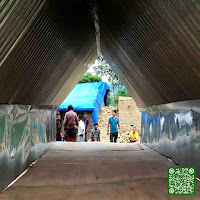1. Bamboo can spread into neighboring yards.
Many homeowners plant bamboo to create a fast-growing privacy screen around their home. Ted Jordan Meredith, author of Bamboo for Gardens, notes that some bamboo species grow more than three feet per day. Bamboo can spread as quickly as it grows, and it doesn’t respect fences or property lines.
Bamboo grows particularly vigorously when adjacent to irrigated lawns and gardens or in low-lying areas that collect water. Instead of just blocking the view of nosy neighbors, you could be turning your property line into a war zone by planting bamboo.
Some bamboo species may even be categorized as noxious weeds, meaning a neighbor could legally force you to remove your bamboo. You could also be liable for the cost of any damage to the neighbors’ property caused by your bamboo, and for the cost of removal from their property.
[ Well if you plant a running bamboo up against a boundary it might well turn out to be invasive. However, there are over 1400 species o bamboo and not all are running bamboos and WEEDS AUSTRALIA has only referred to ONE as 'noxious' LINK. Whatever when we speak of " in your yard" we in Australia are generally talking about the ubiquitios quarter acre house plot, and that is no longer a useful reference as housing plots are shrinking in Australia. Bamboo has proven itself to be a very useful PRIVACYscreen plant and HOMEmakers should not be put off by glib ONEdimensional and somewhat ill informed advice.
HOME making and gardening are two important elements in a community's CULTURALlandscaping. Increasingly, sustainability is an important consideration and bamboo has much to offer in all its diversity. Be mindful and think critcally!! ]
2. Bamboo can be an invasive threat to biodiversity.
Bamboo that spreads and escapes your yard may cause ecological problems as well. Many spreading bamboo species are categorized as invasive exotic plants that crowd out native plants and threaten biodiversity.
The best ways to contain spreading bamboo tend to be expensive and complicated, and may not be worth pursuing for many homeowners. Moreover, they are not foolproof. Experts at the University of Georgia Cooperative Extension recommend burying thick 60-mil polypropylene or fiberglass about three feet deep, and leaving another two inches of material above the soil to inhibit surface spreading. Morgan Judy of Clemson University Cooperative Extension suggests creating a solid barrier made of concrete, metal or pressure-treated wood at least 18 inches deep around the bamboo.
Any of these barriers should stop shallow bamboo rhizomes from spreading, but Judy still recommends closely monitoring the area for escaping shoots, particularly during the early summer peak growing season.
[ Well if you want to, or need to, plant bamboo in "your yard" it is incumbent upon you to do some investigating and from you perspective. One size fits all 'expert advice' tends to support a positioning that fits a purpose rather than being fit-for-purpose in your case. The referencing in the 'advice' here is sound but arguably 'cherry-picked' and somewhat out of context in Australia. The background assumption seems to be that in Australia there is only one viable bamboo species that will grow in "your yard". Not so! And not vso that all alternatives will be likewise invasive – AKA 'noxious'.
There are very good reasons to plant bamboo in "your yard", privacy being one and environmental sustainability being another. So off-the-shelf expert advice needs to be questioned and especially so IF you are pay for it in any way. Thinking of Henry Ford who said "Any customer can have a car painted any color that he wants so long as it is black". Translated to bamboo in "your yard" "bamboo comes in many varieties but in "your yard" every gardener can plant any kind of bamboo just so long as it is a a running bamboo".
Henry sold a awful lot of cars because they were fit-for-purpose and NOT because they were black. Likewise, if you plant bamboo in "your yard" – AKA your CULTURALlandscaping – simply plant a variety that is fit-for-purpose and there many to select from. ONEdimensional advice is what it is, ONEdimensional and generally inappropriate! Critical thinkers know this and what is more, why so.]
3. Getting rid of bamboo can take years.
Bamboo is a long-term relationship that should not be entered lightly. It may take years and vigorous effort to remove unwanted bamboo. The first step in removing bamboo is to remove all the root mass and rhizomes. This is easier said than done, and many homeowners with bamboo-loving neighbors complain they can’t get rid of the spreading grass. No matter how much they dig, the shoots keep coming back.
Judy suggests frequent mowing can deplete and starve the bamboo, but it take at least two years of regular mowing to see any results.
[ Well if you plant a running bamboo for privacy and you have't got bthe space for it it may well become unloved . Here the advisor's own advice is that at the point of becoming 'unloved' your bamboo will be a burden in your CULTURALlandscaping and in its domestic circumstance you will find that unloving it is difficult.
In a CULTURALlandscape where there is space and where bamboo's 'placedness' is appropriate 'controlling' it via harvesting it, removing it is unlikely to be an issue. Humanity has proven itself to be an effective exploiter of the landscape and where the opportunity exists humanity will do so unsustainably and in turn the resource will be diminish or be lost – become extinct even. In this situation human and animal predation will 'naturally' mitigate a running bamboo's tenacity.
In an urban CULTURALlandscape where there is little or no space for a tenacious and invasive running bamboo it is best avoided or ONLY plant it in containment. So the advice here about "your yard" is again ONEdimensional and it needs to be bconsidered bin that context.
Bamboo does indeed have a place in "your yard", sometimes a very important place in your CULTURALlandscaping just so long as you 'plant mindfully' rather than follow status quo thinking. Ronald Regan famously said ... status quo you know is simply Latin for the mess we are in. It iscsometing tonthinkabout]
4. Getting rid of bamboo may require herbicides.
Moreover, Judy notes that chemical herbicides are often necessary for controlling bamboo. This can be a problem for those trying to maintain organic gardens and avoid herbicide use.
Judy recommends Roundup Original, Quick Kill Grass and Weed Killer and other herbicides containing glyphosate. This broad-spectrum herbicide has minimal residual soil activity and typically only kills the plants that are directly sprayed. Mow or chop the bamboo and let it regrow until new leaves expand. Then spray the herbicide on the leaves.
Again, this could take years. One application will not solve your bamboo problem. Also, Judy warns that specialized glyphosate herbicides should be used near creeks, ponds and other surface water. Eraser AQ, Pondmaster and other products are approved for use near water.
[Well if you plant a running bamboo for privacy reasons in an urban CULTURALlandscape and it becomes unloved, chemical use, on the evidence, will by extension will visit unloveliness onto those who use it mindlessly. If a plant becomes a weed because it it is a wrong plant inn the wrong place it is worth remembering who created the problem.
IF in the case of bamboo it becomes unloved, humanity's capacity to unsustainably harvest it will out compete chemicals every time. First have a reason to 'harvest' the bamboo and the do so unsustainably if unloved where it is that is the crux of the matter. Within an urban CULTURALlandscape there are many, many uses for bamboo that in Eurocentric CULTURALlandscape are not recognised but nonetheless need to be.
As the risks involved in mindless use of CHEMICALsolutions reveal themselves chemicals need to be avoided. Here the issue is the chemical driven mindsets not the unloved bamboo. Imagining CHEMICALrisk as reason not to plant bamboo is an exemplar of status quo thinking, the class of thinking that got the world into the 'mess' we as humans have visited upon our planet. So far as we know we only have one, so by extension mindfulness and land literacy become imperatives.]
5. The right bamboo can be hard to find.
Bamboo’s defenders will argue that not all of the more than 1,000 bamboo species are equally invasive. They recommend clumping bamboo species rather than spreading types. The problem is that even clumping species spread, albeit not as vigorously. It also can be hard to differentiate between the types, and some are mislabeled. Moreover, other similar invasive species may be confused with bamboo. For example, University of Arizona Cooperative Extension officials warn against transplanting or encouraging the giant reed (Arundo donax), a bamboo look-alike that has invaded parts of their state.
Bamboo may seem like an attractive garden option, but it poses serious problems. Stick to a lucky bamboo in a small indoor pot, or avoid growing bamboo altogether. Moreover, do your homework before buying bamboo flooring and other products. It may not be as eco-friendly or durable as you think.
For expert help in removing bamboo, hire a professional landscaper.
[Well if you assume that 'the general public' is ill informed, uneducated and disinclined to think critically, and you are you are out and about promoting a 'service' then your advice becomes sullied if not conceited and self serving.
Bamboo IS an attractive garden option and it is worth the effort to become informed as to how attractive, why and in what circumstance. The "serious problems" here comes from ignorance by-an-large and it is unbecoming of a 'professional' to be proffering such inept advice.
Here "bamboo flooring" is used as an exemplar for a BAMBOOproduct that does/might not stack up. Well here we have an exemplar for FIRSTworld thinking and the class of thinking that got the FIRSTworld into the mess that it is, we are, in. The status quoism is astounding and palpable.
If you do not seek you will not find and as the Bible says ... “You shall seek Me, and shall not find Me; and where I am, you cannot come.” John 7:34. More s the pity that this class of ordained Eurocentric thinking that comes with the imprimatur of the enlightenment cum status quo has taken root as an alternative to critical thinking.
As for the advice to "hire a professional landscaper", it turns out that this is American advice to Americans. Therefore, given the state of a country in the process of becoming "GREAT AGAIN" it is advice that needs to be considered very, very, carefully. The subtexts to the subtexts here should be causing the REALworld to set about ringing the alarm bells. In any event the presenters of this questionable 'advice' would do well to watch this TEDx presentation and then reconsider their advice.
"Here's good advice for practice: go into partnership with nature; she does more than half the work and asks none of the fee." ... Martin H. Fischer
 |
| https://www.facebook.com/watch/?v=414766670762384 |











































